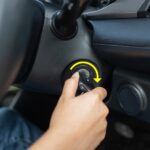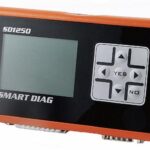Navigating the complexities of modern vehicle diagnostics requires understanding OBD2 protocols. Since 1996, OBD-II (On-Board Diagnostics II) has been mandatory for all cars and light trucks sold in the United States, standardizing vehicle diagnostics. While European OBD legislation presents its own nuances, the core concept remains consistent: providing access to vehicle health and performance data. This article will delve into the world of OBD2 protocols, helping you understand the communication languages your car uses and how to identify them.
Decoding OBD2 Communication Protocols
OBD2 compliance ensures that your vehicle speaks a common diagnostic language, but this language has different dialects, known as communication protocols. These protocols dictate how diagnostic tools communicate with your car’s computer. Understanding these protocols is crucial for anyone involved in vehicle repair, from DIY enthusiasts to professional mechanics. Initially, OBD2 systems utilized a variety of protocols, but standardization has evolved over time. Here are the primary OBD2 protocols you might encounter:
- J1850 PWM (Pulse Width Modulation): Used primarily by Ford vehicles. Identifiable by specific pin assignments in the diagnostic connector.
- J1850 VPW (Variable Pulse Width): Commonly found in GM vehicles. Like PWM, it’s identified via specific pins in the OBD2 connector.
- ISO9141-2: An older ISO standard protocol, often used by European and Chrysler vehicles.
- ISO14230-4 (KWP2000 – Keyword Protocol 2000): Another ISO standard, serving as an evolution of ISO9141-2 and found across various manufacturers.
- ISO15765-4/SAE J2480 (CAN – Controller Area Network): The most modern and prevalent protocol. While US manufacturers were restricted from using CAN until 2003 models, it became mandatory for all vehicles from model year 2008 onwards. CAN is now the dominant protocol globally.
Identifying Your Vehicle’s OBD2 Protocol
Determining your car’s OBD2 protocol often involves a physical inspection of the Diagnostic Link Connector (DLC), standardized under SAE J1962. This connector is usually located within the driver’s compartment, easily accessible from the driver’s seat. SAE J1962 defines two connector types: Type A and Type B, differing mainly in the alignment tab shape.
Figure 1 – J1962 Type A DLC Connector
Figure 2 – J1962 Type B DLC Connector
The key to protocol identification lies in examining the pinout of your vehicle’s DLC. Certain pins are associated with specific protocols. Figure 3 illustrates a typical OBD2 connector pinout:
Figure 3 – J1962 OBD2 Connector Pinout
The table below summarizes how to identify the protocol based on which pins are populated in your OBD2 connector:
| Pin 2 | Pin 6 | Pin 7 | Pin 10 | Pin 14 | Pin 15 | Protocol |
|---|---|---|---|---|---|---|
| Must | – | – | Must | – | – | J1850 PWM |
| Must | – | – | – | – | – | J1850 VPW |
| – | – | Must | – | – | May* | ISO9141/14230 |
| – | Must | – | – | Must | – | ISO15765 (CAN) |
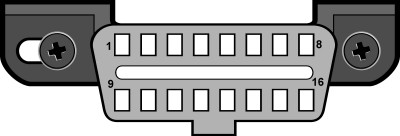
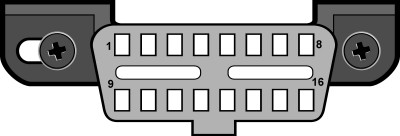
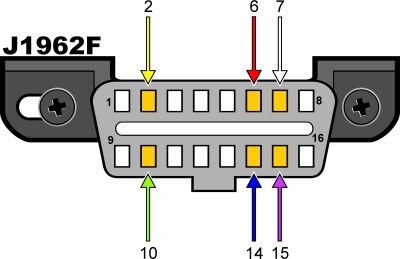
*Pin 15 (L-line) might be present in older ISO9141-2/ISO14230-4 implementations.
Furthermore, all OBD2 connectors must have Pin 4 (Chassis Ground), Pin 5 (Signal Ground), and Pin 16 (Battery Positive). This baseline, combined with protocol-specific pins, allows for protocol determination:
- PWM: Pins 2, 4, 5, 10, and 16 are present.
- VPW: Pins 2, 4, 5, and 16 are present, but Pin 10 is absent.
- ISO: Pins 4, 5, 7, and 16 are present. Pin 15 may or may not be present.
- CAN: Pins 4, 5, 6, 14, and 16 are present.
OBD2 Protocol and Car Manufacturers: Accessing Protocol Lists
While this guide helps identify protocols based on connector pinouts, a direct “Obd2 Protocol Car List” in the form of a comprehensive table is challenging to maintain due to the vast number of car models and model years. However, understanding manufacturer trends and utilizing resources can aid in your search.
For a general overview of protocols used by different manufacturers, the following resource can be helpful: OBDII Generic Communication Protocols by Manufacturer. Keep in mind this list might not be exhaustive or completely up-to-date, but it provides valuable insights into historical protocol usage across brands.
In conclusion, while a definitive “obd2 protocol car list” is elusive, understanding the different OBD2 communication protocols, how to identify them via DLC pinouts, and knowing general manufacturer protocol preferences empowers you to navigate vehicle diagnostics more effectively. By combining physical inspection with available resources, you can confidently determine the OBD2 protocol your vehicle utilizes and ensure compatibility with diagnostic tools.
